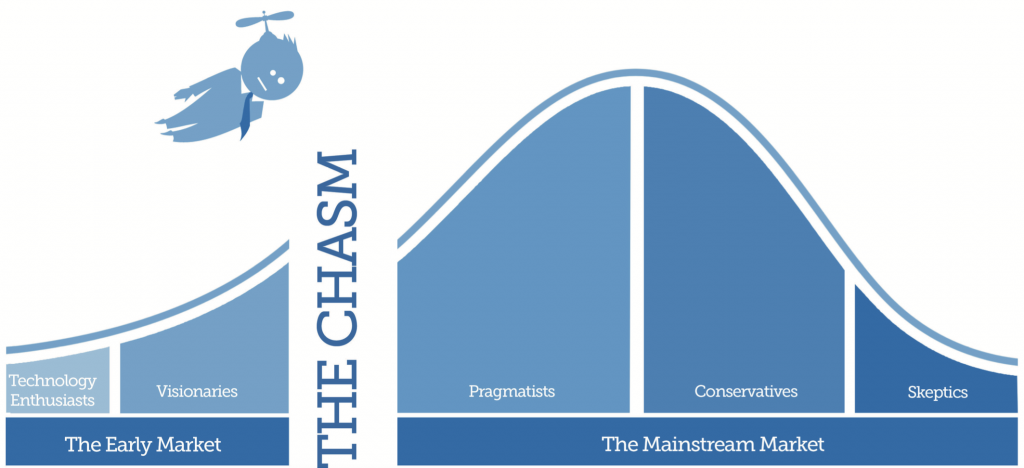On the inside of Hubspot and the trouble with marketing technology
Demonstrating the power of social media, I found Dan Lyons‘ book Disrupted – My Misadventure in the Start-Up Bubble in a post by one of my connections on LinkedIn. It was the name Hubspot that caught my attention and as I read the post by Dan Lyons I immediately decided to buy and read his book.
As if to highlight the times we are living in, when I downloaded the book to my Kindle I was in a Starbucks café in Istanbul in Turkey, so that I could read it on the train to the Atatürk airport and on the flight back to Denmark later the same day. I finished the book before turning the light off in my own bed in Copenhagen the same night. Not because it is short (267 pages), but because it is a great read. I just couldn’t put it down.
Summary
Dan Lyons is a Newsweek technology reporter who at the age of 52 is made redundant. The newspaper and magazine business is suffering from the disruption caused by the Internet and as a consequence Dan gets axed from his prestigious job with Newsweek in June 2012. Getting a new job as a journalist (with a decent salary) in the good old media business is close to impossible and after a few short intermezzos Dan lands a job with the tech startup Hubspot in Boston in April 2013. He is now on the inside of an industry he has written about from the outside for decades. It turns out from day one that Dan and Hubspot are a poor match and over the course of 267 pages Dan describes his tough time in the Hubspot “nut house” including reflections on an industry where companies have become financial instruments rather than genuine businesses delivering value to customers, employees, shareholders and the community. According to Lyons the US information technology startup scene seems to have lost any trace of decency and business ethics.
The book is well written, sharp and humorous. There is a good mix of Dan’s personal experience with the Hubspot way of running a business and reflections on the US information technology startup industry. Dan’s flirt with Hubspot doesn’t go well and reading his observations is super entertainment.
Tweet: Absolutely worth reading for anyone interested in reading books.
But Dan is also a little spoiled from his time as a reporter on prestigious magazines such as Newsweek and Forbes and there are some sides to and environmental changes in the information technology industry that he doesn’t quite understand or at least doesn’t appreciate.
I am currently writing a business biography myself (not about myself though) and so am familiar with the differences between the public image of companies (even as portrayed by the free and independent press) and the reality behind the scenes. My biography is about people with a lot more substance than what Dan Lyons apparently has experienced in the US startup circus, but still. However, the times are certainly changing and let me give a little rundown of my own “midway crises” which may explain why I believe Dan was unfortunate and landed in a place he doesn’t understand and appreciate.
Over 50 and what was is not what I want next
In 2001 at the age of 50 I was fed up with corporate life. I was tired of being a hired CEO, tired of managing people, tired of the never-ending pressure of delivering the numbers others had defined and tired of corporate politics. I was not tired of business, not tired of business development, not tired of marketing and not tired of sales. I just didn’t want to report to anyone and I just didn’t want anyone reporting to me. Okay, I had also just been pink slipped from a company that I used to love working for (then it was merged with another company and lost its’ soul). I was without a job, but getting a new job was the last thing in the world that I wanted.
So I started my own company. I became a business angel.
The new startup world
Then my phone rang.
It was a headhunter. There was this startup that had just finished their A-round and needed a CEO. They were 12 engineers and had no one to take care of the commercial side of things. They needed someone like me to find a market for the technology. There was this business plan from the A-round and there were stock options.
I was a business angel without anyone to shine my light on, so I jumped on the startup. The good thing was that they didn’t want my money (the thought of dilution made the investors go pale), but payed me a handsome fee for my services. I was off to a good start in a no-risk scenario. Life as a business angel looked promising.
 The business plan from the A-round turned out to be genuine and solid wishful thinking. It took me a couple of weeks and some field interviews to verify that the type of customers that the investors had in mind were delighted with what they already had and didn’t see any value in changing. The market segment that the investors had chosen was very small, the customers had no money and applying the technology could not be justified with any financial data. It was a pure “nice to have” scenario that the potential customers deemed “not nice to have.”
The business plan from the A-round turned out to be genuine and solid wishful thinking. It took me a couple of weeks and some field interviews to verify that the type of customers that the investors had in mind were delighted with what they already had and didn’t see any value in changing. The market segment that the investors had chosen was very small, the customers had no money and applying the technology could not be justified with any financial data. It was a pure “nice to have” scenario that the potential customers deemed “not nice to have.”
I found another market. It was a small market in terms of the number of potential customers, but a market that was prepared to pay big bucks for our technology – if we could make it work. We were in Denmark and the market was in Hollywood, but what the heck. “Born global” was the motto of the times and we ploughed ahead.
After spending the two million dollars from the A-round we realised that we couldn’t make the technology deliver the quality required for the big bucks to flow and making it work would require at least ten million additional dollars and a couple of additional years in the lab. No one (including this business angel) was prepared to come up with the means to carry on so we folded the project.
Multichannel marketing
I am in my business angel office with a couple of more successful engagements under my belt again looking at the crystal ball when the phone rings.
It is an old friend of mine.
 It is now 2004 and over the short time span of just 10 years the Internet has changed the world. Newspapers and magazines are bleeding as advertisers are reallocating their spending to the new online media (where their readers are). My friend has started a company developing technology for multichannel marketing and needs someone to run the Danish operation. I am the right profile for the job. Well, it is not a job in the sense that they can pay a salary. It is an investment opportunity. I can get a nice share of the company for a very low price if I am prepared to be paid a percentage of the revenue in exchange for my operational engagement.
It is now 2004 and over the short time span of just 10 years the Internet has changed the world. Newspapers and magazines are bleeding as advertisers are reallocating their spending to the new online media (where their readers are). My friend has started a company developing technology for multichannel marketing and needs someone to run the Danish operation. I am the right profile for the job. Well, it is not a job in the sense that they can pay a salary. It is an investment opportunity. I can get a nice share of the company for a very low price if I am prepared to be paid a percentage of the revenue in exchange for my operational engagement.
This is a genuine business angel opportunity and as I believe that there is a market for multichannel management systems I get onboard.
After reading Dan Lyons’ book I can now see that the company was (R.I.P.) an early version of Hubspot just without the orange culture trimmings (and maybe that was a mistake).
Selling technology to SMB marketers
The company is underfunded and my investment doesn’t change the situation. We need revenue now and we have two sales strategy options:
A. We can sell to big enterprises. They have the need, they have the money and they have the people who understand what multichannel marketing is all about. But big enterprises are risk averse, they don’t like to dance with startups and they take ages to make decisions.
B. We can sell to the SMB market (small and medium sized businesses). There are many of them, they have the need, they make decisions much faster and they don’t know the risk of dancing with startups.
We go for option B.
 Small and medium sized companies do have a desperate need for multichannel marketing – in 2004 they just don’t know it yet. Multichannel marketing requires an engineering approach to marketing and a broad set of skills that small and medium sized companies simply don’t have. Selling our software-as-a-service based subscriptions for $1,500 a month is a tough job, but enabling the customers to really use the solution and verify the value is an even tougher job.
Small and medium sized companies do have a desperate need for multichannel marketing – in 2004 they just don’t know it yet. Multichannel marketing requires an engineering approach to marketing and a broad set of skills that small and medium sized companies simply don’t have. Selling our software-as-a-service based subscriptions for $1,500 a month is a tough job, but enabling the customers to really use the solution and verify the value is an even tougher job.
The distance between the technology we offer and the working solution the customers need is very wide. I make an analysis and find out that the technology we provide is less that 10% of the solution. The rest is the business process engineering, the technical engineering and the content creation, all of which we don’t provide and which the SMB customers are also not really prepared to invest in.
We invent a seminar program teaching multichannel marketing. We charge for the seminars and people flock to hear about the new black. Our administration (which is also me) gets bogged down with sending out hundreds of small invoices for seminars and making sure people pay on time (Eventbrite wasn’t invented in 2004).
We have case stories, white papers, eBooks and Return on Investment models. Seminar attendees are overwhelmingly positive and the evaluations are fantastic, but we don’t sell enough subscriptions and the churn is way too high.
The partner strategy
The marketing agencies that used to make brochures and ads for their clients must be the right people to now teach them how to do multichannel marketing and then sell our subscriptions to them.
What we cannot sell ourselves the partners can sell. And then they can sell all the services required to release the value for the customers.
Only they cannot.
In 2004 the marketing agencies are fundamentally conservative and reactive. They are mostly afraid of new technology and hate the new times just as much as their friends in the media world. They don’t quite understand multi channel marketing yet and don’t have the technical skills required for the engineering part of the job.
I give up
“Never give up” is a slogan I often hear, but really don’t understand. It’s like fighting to the last man. Honourable maybe, but it prevents you from fighting again another day. You should never give up breathing, but there are many other things it makes perfectly good sense to give up (smoking and drinking for instance).
After doing a thorough analysis I come to the conclusion that selling information technology to marketers in the SMB market in Denmark in 2004 is an uphill battle on a rainy day and a gale in your face.
I give up. Maybe I am a coward and jump ship, but I don’t see the meaning in continuing something I don’t believe in. I thought it was possible to sell marketing automation to SMB marketers. Maybe it was possible, but I couldn’t figure it out. Face the brutal facts and move on. So I did. The other shareholders bought my shares for the same price as I paid, so I didn’t suffer a loss. History should show that I was the only one “making money” on my shares.
Hubspot
![]()
![]()
 Years later I come across Hubspot.
Years later I come across Hubspot.
Hubspot is apparently pulling off what I failed to pull off in 2004. I can see that they are unprofitable, but they put on a good show. They are not past the tipping point yet and therefore have to invest heavily in sales and marketing. Maybe that will change when they get past 20% market share.
I read their blogs and find some of the stuff they write quite good. I share it on social media and even include some of it in my biweekly eJournal that goes out to my 10.000 + subscribers.
I don’t run a business that needs Hubspot’s software, but I like their content.
I read a book written by Mark Roberge (Hubspot Chief Revenue Officer) called The Sales Acceleration Formula and like it. I write a review of the book. I read the book Inbound by the Hubspot founders Brian Halligan and Dharmesh Shah. Not bad either though not in the same league as the one by Mark.
I watch some videos from the Inbound conference with Brian Halligan and Dharmesh Shah and am not so impressed. Their performances don’t appeal to me, but the audience seems thrilled. I browse the Hubspot culture presentation by Dharmesh Shah and think myself lucky that I am out of the corporate circus. However, Brian Halligan and Dharmesh Shah seem to know what they are doing and in general I find that Hubspot is on a noble mission picking up where I left off in 2004. There is need for what they do and I hope they will become successful. Selling even great stuff is really difficult for most companies and Hubspot is on a mission to make it easier. This all makes good sense.
Marketing and sales in the 21st century
I enjoyed reading Dan Lyons’ book about his time with Hubspot and can recognise some of the bizarre things going on, especially in the US information technology startup scene, but having been in global marketing and sales in the IT industry since 1980 I can also recognise some of the fundamental changes and new challenges we are facing. Changes that make companies like Hubspot behave as they do.
My first technology startup was in 1986 and we landed on the moon (and returned with our pockets full).
Since then I’ve been involved in several startups. Some failed and some became very successful.
What has changed over the last 36 years where I have been engaged in the global information technology industry?
The main difference is that the window of opportunity for information technology companies is much shorter in this century than it was in the last century. And these windows of opportunity keep shrinking. People across the globe get the same ideas at the same time. The transparency provided by the Internet make all markets hyper competitive. We need to move much faster getting our products to the market. If we don’t make it to 20% market share before our competitors, chances are that we will be wiped out. The winner takes it all.
Prices of information technology keeps decreasing. The PC-based financial management software we sold for $4.500 per user in 1984 now has a $250 price tag – with a better user interface and more functionality. And now we can even get it for free in the cloud while the provider is looking for a new business model.
The law of diffusion of innovation
The law of diffusion of innovation has not changed. People are still reluctant to adopt new technology and that is why many information technology companies have to fake it until they can make it. That’s why they have to invent “movements” and “hype waves” and position themselves as the leading force in those self-inflated tornadoes. That’s why we have freemium business models where customers can get started by paying nothing. We must invent reasons to act now and at the same time reduce the risk of trying our technology.
Business economics have not changed. No information technology company can survive in the long run unless they can find a business model where the revenue is bigger than the cost. To do so they must provide something where the value to the customer (whoever she is) is higher than the price they charge and where the gross margin can cover the expenses and yield a profit that is big enough to reinvent the business again and again. (Getting to the top and staying at the top are two completely different exercises.) But few information technology companies can get to this state the way we did it in the last century where we were profitable right out of the garage (or at least with very little up front investment) and had time to grow. That’s why the Silicon Valley model has developed and that’s why investors can accept that their portfolio companies can lose billions of dollars. It is the race to get to the tipping point before the others. Profits come later.
Velocity is king
 I write for and work with technology companies with ambitions for global market leadership and I know that we need to get our buts off the seats and move fast (but not faster than we can correct the course along the journey). To me marketing and sales is pure business process engineering and when a boiler room of people for “inside sales development” is required (which it very often is) then we call in the cleaning experts from Pulp Fiction (I am a business engineer – not a cheerleader. Both types are required).
I write for and work with technology companies with ambitions for global market leadership and I know that we need to get our buts off the seats and move fast (but not faster than we can correct the course along the journey). To me marketing and sales is pure business process engineering and when a boiler room of people for “inside sales development” is required (which it very often is) then we call in the cleaning experts from Pulp Fiction (I am a business engineer – not a cheerleader. Both types are required).
Maybe Hubspot has taken it a bit too far, but information technology companies in general have to fake it until they can make it. They have to find a way to get to the mainstream market before the mainstream is prepared to deal with them. That’s called crossing the chasm and if you don’t make it across then you are doomed.
It has nothing to do with changing the world or making it a better place. These are just necessary party lines. It is about cashing in on the investments along the way. Someone will win big, but most will lose it all. It’s casino business. It’s a lottery with the feeling of having some control. It may not look pretty, but that is the model that works. It would be great if we could get out of the earth’s gravy field using only one rocket, but that is not possible. Getting an information technology startup through the various growth phases requires specialised skills and money at each step.
I do hope Hubspot becomes a profitable company and everybody get their money back, but for now we just don’t know if that’s going to happen. Let’s wish them good luck and hope for the best. The world actually needs the kind of software and services that Hubspot provides, but the world needs to be educated first to realise that this is the case (and then find the skills and resources required to execute on top of the software).
In the meantime I suggest you read Dan Lyons’ book and have a good laugh. Maybe he suffered during the 21 months he lived in the Hubspot world, but what doesn’t kill you makes you stronger and he seems to be doing alright now. And I assume Hubspot will be doing just fine without Dan Lyons too.
Hubspot’s response to Dan Lyons’ book can be found here: Undisrupted: HubSpot’s Reflections on “Disrupted”
And now everybody needs to go and do what they do best.
Other reviews:
Dylan Martin: Like It Or Not, Dan Lyons’ ‘Disrupted’ Is An Important Conversation Starter
Ilan Mochari: Why Dan Lyons Thinks ‘Disrupted’ Is More Than a Hubspot Takedown
Jeffrey Davis: The Job at HubSpot That Dan Lyons Actually Wanted
Sherry Toplyn: Dissed and Dismissed by HubSpot? Disrupted by Dan Lyons Tells All
Jason Del Rey: A 52-year-old tech journalist went to work for a startup. It did not go well.














